#ahmose
Photo
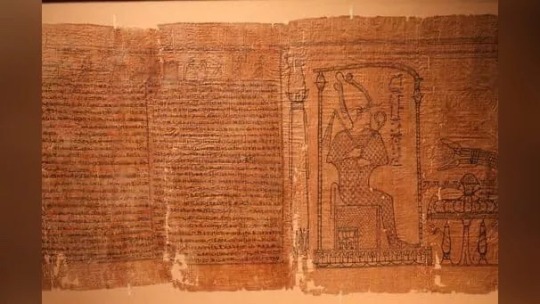
The 52-Foot-Long Book of the Dead Papyrus from Ancient Egypt
Egypt has released photos of a newly discovered Book of the Dead from more than 2,000 years ago.
Egyptian officials have released photos of an ancient scroll, the 52-foot-long (16 meters) Book of the Dead papyrus recently discovered in Saqqara. The 10 images show ancient illustrations of gods and scenes from the afterlife, as well as text on the document, which is more than 2,000 years old.
Archaeologists discovered the Book of the Dead papyrus within a coffin in a tomb near the Step Pyramid of Djoser and announced the discovery on Jan. 14 for Egyptian Archaeologists Day, but this is the first time they've released images of the scroll to the public.
It was not unusual for ancient Egyptians to bury the Book of the Dead with the deceased, but they didn't call it that at the time. Rather, modern archaeologists coined the term "Book of the Dead" to refer to a collection of texts that ancient Egyptians thought would help guide the dead in the afterlife.
Papyrus for the dead
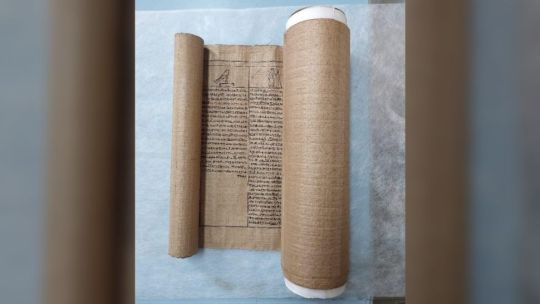
The 52-foot-long scroll was found at Saqqara in May 2022. It contains chapters from the Book of the Dead. It was recently restored and translated into Arabic and is now on display at The Egyptian Museum in Cairo. The text is written in hieratic, a script derived from hieroglyphs.
All rolled up

The papyrus was found rolled up in a coffin belonging to a man named Ahmose (not to be confused with a pharaoh who lived in earlier times). The man's name is mentioned in the papyrus about 260 times, the researchers said. He lived around 300 B.C., near the beginning of the Ptolemaic dynasty, a dynasty of pharaohs descended from one of Alexander the Great's generals.
Carefully unrolled

A team of researchers performed extensive conservation work so they could unroll the papyrus. Ahmose's tomb is located south of the step pyramid, built for Djoser, a pharaoh from the third dynasty who ruled from about 2630 B.C. to 2611 B.C. While this pyramid was built long before the time of Ahmose, it wasn't unusual to find Ahmose's tomb there, as people in ancient Egypt sometimes liked to be buried near the pyramids of long dead pharaohs.
Analyzing the scroll

The unrolled papyrus is seen here. It was written in black and red ink, and the quality of the writing indicates that it was written by a professional, researchers said. Despite the size of the scroll, there are longer Book of the Dead texts known from Egypt. For instance, a Book of the Dead papyrus, which is now in the British Museum, was originally 121 feet (37 m) long.
Book of the Dead on display

The unrolled papyrus on display at The Egyptian Museum in Cairo.
Ancient illustrations

This Book of the Dead text also contains illustrations. This image appears to show Osiris, the ancient Egyptian god of the underworld. In Egyptian mythology, Osiris' life was ritually restored after he died — something that ancient Egyptians hoped would happen to them in the afterlife.
The deity Osiris

This image shows more details about Osiris. He is shown sitting on a throne while wearing an "Atef" crown, a type of crown often gracing the head of Osiris. There appear to be offerings before him, as well as a creature who may be Ammit, a deity who consumed anyone who was not worthy of being ritually restored in the afterlife.
Husband and wife
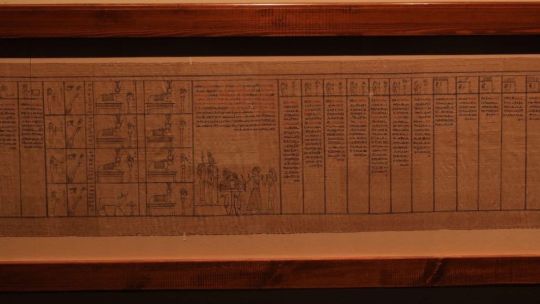
This image appears to depict offerings and a scene of a couple venerating Egyptian deities. This couple may be Ahmose and his wife (whose name is not known). Not much is known of Ahmose, but he was wealthy enough to have an elaborate copy of the Book of the Dead made for him.
Leading the cow

A number of scenes are illustrated in this section of the Book of the Dead. At the far left, a cow appears to be led somewhere — perhaps to be given as an offering. A number of images depict boats, which could be used to navigate the underworld.
Weighing against a feather
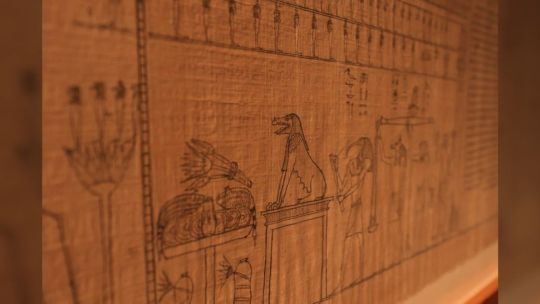
This close-up shows a creature, possibly Ammit, sitting before Osiris. In ancient Egyptian mythology, the heart of the deceased is weighed against the feather of Maat, a god associated with truth, justice and order. If the person's bad deeds in life were great, their heart would be heavier than the feather, and Ammit would devour the deceased.
By Owen Jarus.
#Book of The Dead#Saqqara#Step Pyramid of Djoser#afterlife#ancient tomb#ancient grave#ancient artifacts#archeology#archeolgst#history#history news#ancient history#ancient culture#ancient civilizations#ancient egypt#egyptian history#egyptian hieroglyphs#egyptian art#ptolemaic dynasty#ahmose#The 52-Foot-Long Book of the Dead Papyrus from Ancient Egypt
382 notes
·
View notes
Text
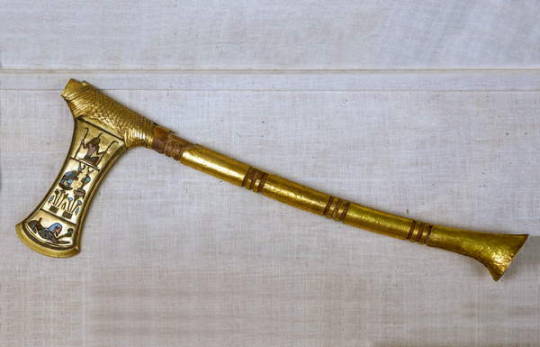
Ceremonial Axe of Ahmose I
New Kingdom, early 18th Dynasty, ca. 1550-1524 BC.
Now in the Luxor Museum.
The Ceremonial axe of king Ahmose I, the founder of the 18th Dynasty. Decorated with scenes, the king appears in the form of a sphinx, Nekhbet as a vulture over lily as symbol of Upper Egypt, Wadjet as a cobra over papyrus as symbol of Lower Egypt.
Finally scene “Heh” the god of eternity holds the plant signifying millions of years. This axe was executed to commemorate the liberation of Egypt from the Hyksos. On one side are the king’s cartouches at the top, a representation of Ahmose striking down his enemy in the center, and a winged sphinx symbolizing the king at the bottom.
Read more
43 notes
·
View notes
Text
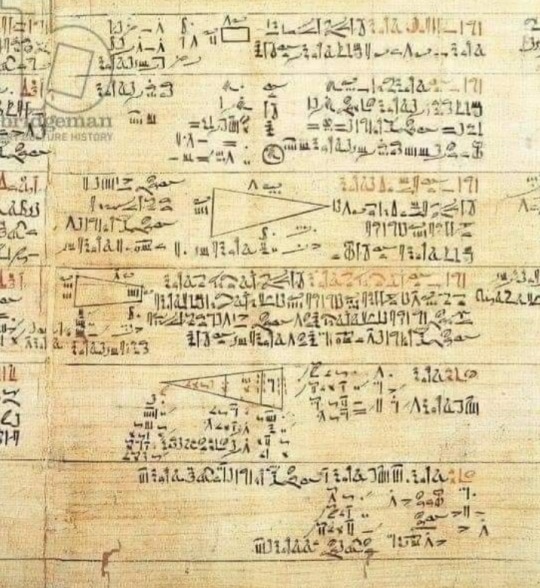
Papyrus of Ahmose or Mathematical Rhind (1500 BC / 1550 BC) is the oldest manuscript written in Algebra and Trigonometry.
Manuscript shows that Egyptians used first-order equations and solved them in several ways.
They know quadratic equations and solve them. They also know numerical and geometric sequences and know quadratic equations like two :
X2 + y2 = 100,
Y = 3/4 x, where x = 8, y = 6,
This equation is the origin of Pythagoras theorem, a2 = b 2 + c 2, and Egyptians used to call unknown number (koom).
Pythagoras developed his mathematical theories after travelling to Egypt and learning from Egyptian priests.
This has been proven in books of Greek historians and scholars such as Farpharius of Sour, Herodotus, and Thales.
Egyptians had Algebra, Trigonometry, and Geometry about 2000 years before the birth of Pythagoras and about 3000 years prior to al-Khwarizmi being born.
—
The Rhind Mathematical Papyrus (RMP; also designated as papyrus British Museum 10057 and pBM 10058) is one of the best known examples of ancient Egyptian mathematics.
It is named after Alexander Henry Rhind, a Scottish antiquarian, who purchased the papyrus in 1858 in Luxor, Egypt.
It was apparently found during illegal excavations in or near the Ramesseum. It dates to around 1550 BC.
#Papyrus of Ahmose#Mathematical Rhind#Rhind Mathematical Papyrus#manuscript#Pythagoras#Pythagoras Theorem#Ancient Egyptian Mathematics#Ancient Egypt#Alexander Henry Rhind#papyrus#Achaeo Histories#algebra#geometry#mathematics#Ahmes#Ahmose#Egyptian civilization#Trigonometry#mathematical theories#Hieroglyphs#Ramesseum
85 notes
·
View notes
Text

Amr said that friends that go to the gym together have some sort of special name in the future. Or at least that's what Aya told him. Something about guy mice...I don't know.
#Sims 3#Millennia Challenge#Ahmose#Pink Gen 1#Amr Madbo#Madbo Family#Madbo Gen 1#gym rat#that's what he meant lol
14 notes
·
View notes
Photo

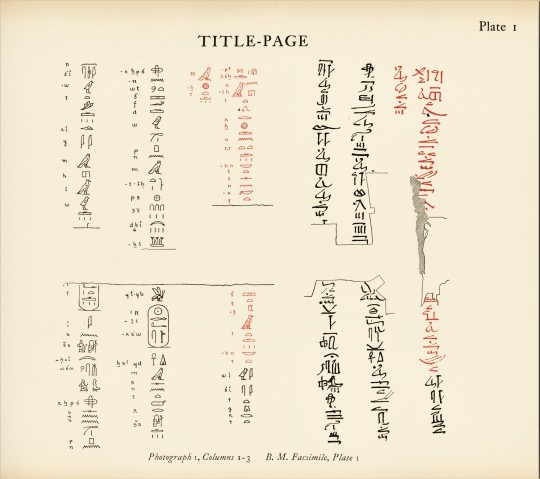
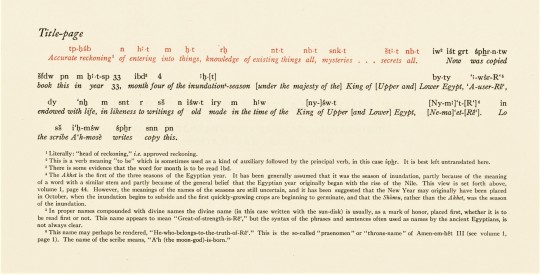



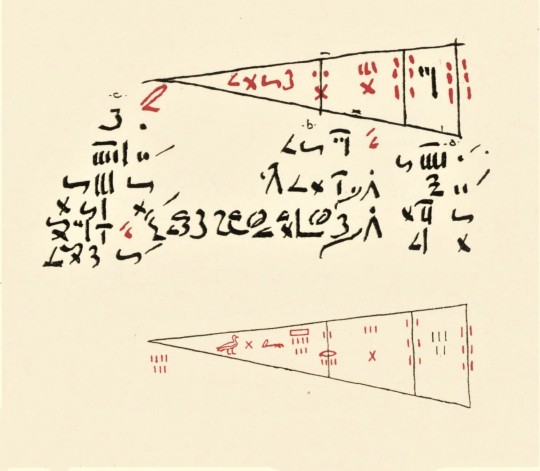



An Egyptian Mathematics Science Saturday
While Archimedes of Syracuse (287-212 BCE) is often considered the first to calculate the value of Pi (π), the Egyptians got pretty darn close a millennium and a half or so earlier, as evidenced by the Rhind Mathematical Papyrus. Copied by the scribe Ahmes sometime around 1650 BCE from an earlier text, the papyrus gives us a remarkable insight not only into Egyptian mathematics but also customs and culture, from taxation and farming practices to the exchange rate between beer and bread. It is named after Scottish antiquarian Alexander Henry Rhind, who acquired the papyrus sometime around 1858. Held by the British Museum since 1865, it is now suspected that the papyrus entered the antiquities market as a result of illegal excavations.
Our facsimile of the papyrus was the result of fifteen years of scholarship by mathematician Arnold Buffum Chace. The first volume was published in Oberlin, Ohio by the Mathematical Association of America in 1927, with the second volume following in 1929. All of the above images are from the second volume, which contains photographs of the papyrus, as well as transcription transliterations and literal translations by Chace. Chace was assisted in his work by mathematician Henry Parker Manning and Egyptologist Ludlow Seguine Bull. Also included in the second volume is a supplement to the “Bibliography of Egyptian Mathematics” from the first volume, both of which were prepared by Raymond Clare Archibald.
The first publication of the Rhind Papyrus was a translation into German in 1877 by August Eisenlohr. The Mathematical Association of America publication was part if a flurry of new scholarship surrounding the papyrus following advancements in scholarly understanding of Egyptian writing. In the preface to our edition, Chace notes the important 1923 translation by Eric Peet published by Liverpool University Press. Chace remarks that “Egyptologists ... will find philological matters fully discussed by Professor Peet,” while he intended for his work to be geared towards both mathematicians and the general public.
Both volumes were originally donated to the Library of the State Teachers College Milwaukee by the Carnegie Corporation of New York with their bookplate.
Check out more Science Saturday posts here.
-Olivia, Special Collections Graduate Intern
#Science Saturday#Rhind Papyrus#Rhind Mathematical Papyrus#Ahmes#Ahmose#Alexander Henry Rhind#Arnold Buffum Chace#Arnold Chace#Mathematical Association of America#Henry Parker Manning#Ludlow Seguine Bull#Raymond Archibald#August Eisenlohr#Eric Peet#Mathematics#Mathematics in Antiquity#Antiquities#Papyrus#olivia
34 notes
·
View notes
Note
[meme thing to ahmose] “How do I show people that I’m more than my unethical career choice?”
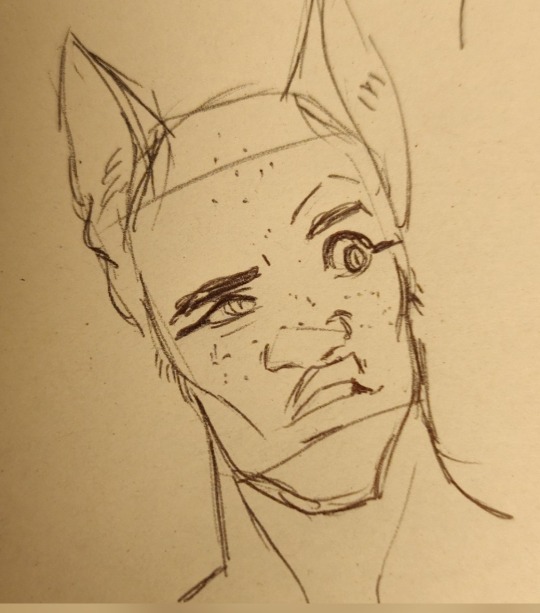
"Normally being a decent person gets that across to people. Did you happen to anger the Goddess again?"
2 notes
·
View notes
Note
💬 and 🖊 + for Lord Meryamun Ankhkemet!
"You know... it kills me to say it but at least you [insert character name] and [insert character name] were luckier than I ever was..."
"Because we grew up with each other and you grew up alone ?"
"Yes... but mostly because you are orphans..."
-characters whose name I won't say yet from an original story I've been working on for 9 months now I hope to make a serial webcomic of one day (@chaifootsteps and @dracocheesecake know about it because I keep them updated everyday of new things I invenr and add to it, it originally started as a dream of a franchise I loathe I know they have beef with too which was much better than reality that surprised me for how much I loved it then I realized it was a dream and the good elements were from my mind so I told them and they encouraged me not to make it go to waste and I added another dream I had liked from the year before but did not know what to do with to add characters and an episode plot so 9 months later it went from "I dreamt a story I hate wad actually great and written like I would have written it" to its own whole original thing with its own lore, style and characters with just a few common points left), when the bully character opens up to one of the main characters they were a dick to until now and starts their redemption arc
OK as for Meryamun : until he got drunk with power and the ambition of becoming a pharaoh one day, and ditched them as a young adult, Meryamun had 3 childhood friends he grew up with. Neferet I told y'all about he ended up falling in love with shortly and whom he regrets the most for breaking her heart, User a big tough guy who likes to fight but is a gentle giant, and his cousin Kheti who studies to become a scribe his father Maya and Meryamun's father Neferhotep hope would be rivals because they are brothers with a rivality but their sons didn't want to be part of it. They all grew up together for being royal palace's staff's children, Meryamun being the son of Neferhotep (embalmer high priest) and Meresankh (ritualistic musician), Kheti of Maya (scribe high priest) and Ahmose (doctor high priestess), User of Djau (general) and Hetepheres (perfume maker) and Neferet of Sneferu (chief treasurer) and Isetnofret (servant)
I consider making a spinoff of The Ankhkemets focusing on his shenanigans as a teenager with his buddies because ever since I was little I was OBSESSES with Ancient Egypt and FINALLY I found an idea of a story to incorpor Ancient Egyptian everyday elements and be both funny and educative
#moi#ask#ocs#family#parents and children#cousins#brothers#FRIENDS !#neferhotep#meresankh#user#maya#kheti#djau#neferet#sneferu#isetnofret#hetepheres#ahmose#growing#palace#enemies#dracocheesecake#chaifootsteps#comics#quote#dreams#sunstar-of-the-north#meryamun ankhkemet#the ankhkemets
3 notes
·
View notes
Photo

Ahmose • Spear of Sumeru • Pyro Polearm
Ahmose is a Genshin Impact OC I made. He’s their premiere fighter, most skilled with the polearm. I don’t know much about Dehya yet, but I’ve headcanoned him as her older brother.
2 notes
·
View notes
Text
Taart vandaag: pi-dag!
Ter gelegenheid van Pi-dag liet ik Chat GPT een tekst schrijven, en zoals gewoonlijk goot die babbelbox mijn scherm vol letters. Maar er werd beweerd dat de Oud-Egyptenaren pi gebruikten bij de bouw van piramiden, al zitten daarin alleen driehoeken en vierkanten. Waarom zouden ze daarvoor pi gebruiken? Zoals gewoonlijk was de kletsfabriek verdwaald in de massa’s tekst op internet, en had ze…

View On WordPress
#ahmes#ahmose#berlijn-papyrus#cirkel#diameter#driehoek#kahun-papyrus#moskou-papyrus#oud-egyptenaren#papyrus#pi#pi-dag#pi-day#piramide#rechthoek#rhind
0 notes
Text


kittycat with a very unique looking face had a two hour nap on my lap. i like to joke that ever since adopting sunlight, orange cats gravitate towards me now lmao
29 notes
·
View notes
Text

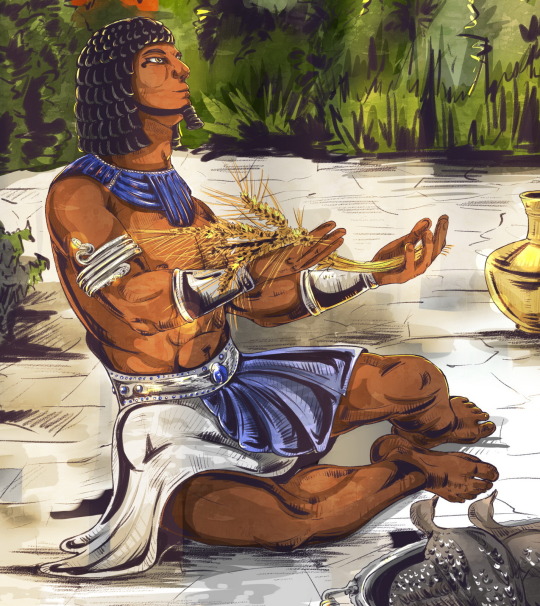

Ahmose I (Ahmes I) was a pharaoh who reigned approximately 1550 - 1525 BC. e., and is the founder of the 18th dynasty.
He was never particularly popular or known and that’s the reason that made me draw this picture so that people would remember him or learn about him.
Ahmose's reign began on the day he came of age (at the age of 16), by which time his heroic father Seqenenra Taa II was already dead (he died not from intrigue, as you might think, but in a battle with the Hyksos). Ahmose's mother, Queen Yahhotep, initially ruled together with her son until he got married. Having blessed the couple to have a long and happy life, she finally retired from political affairs (not really).
Ahmose continued the war with the Hyksos because his father’s work had to continue and his death had to be avenged. The brave pharaoh set his sights on the very capital of his vile enemies. The young pharaoh entered into an alliance with Crete, which was famous for its unsurpassed fleet (And also for dancing with bulls and a centralized water supply, but that’s another story). He led the combined fleet to Avaris, a fortified city located on the Nile Delta, which made approaches to it from the river quite convenient. Nevertheless, the siege lasted for an indecently long time and only in the 11th year of the reign of Ahmose, the city was captured through a fierce assault. Many hands were cut off, and the water was stained with blood to the delight of the alligators. The unfortunate Hyksos were forced to retreat all the way to Asia, liberating all of Lower Egypt.
But this did not stop Ahmose. The thirst for revenge and the desire to protect Egypt from further encroachments by the Hyksos forced him to capture the Sharukhen fortress in Palestine. The last stronghold of his enemies fell.
All this time, Queen Yahhotep did not sit idle and actively helped her son in military activities, earning awards for her valor (perhaps we will talk about her in our next illustrations). Recapturing Egypt became the greatest deed in the life of Ahmose (which, you see, is quite impressive).
While the young pharaoh was engaged in his military activities (after all, as you know, once you start, it’s impossible to stop), his still fragile power over Egypt weakened. Uprisings began. However, they were successfully suppressed, thus finally strengthening him on the throne.
Finally, as he grew older, Ahmose’s ardor subsided and he began construction work. However, he was not so good in this field and practically not a single building of Ahmose has survived to this day. However, during his time new quarries were opened for the construction of temples, so everything is not so bad.
Ahmose's mother and grandmother were quite strong women who actively participated in political and even military activities until their last day. The first wife of Ahmose, Ahmose-Nefertari, also did not lag behind her relatives. All these women overshadowed Ahmose himself (we will not write about their deeds here). However, he loved his family and treated them with respect, which is reflected in some frescoes and in the records of scribes.
The painting reflects my interpretation of the fresco on the stele that Ahmose dedicated to his grandmother Tetisheri after her death. Here he makes offerings to her.
Ahmose died early, he was about 40 years old. After his death, his son Amenhotep I took the throne.
If you want to know more about this pharaoh, but don't want to read boring historical texts, there are works of fiction on the topic. Ahmose is the main character in Naguib Mahfouz's novel The War of Thebes and Christian Jacques's Wrath of the Gods trilogy. Both works tell the story of the liberation of Egypt from the rule of the Hyksos.
Artstation | Deviantart | VK | Commission List
#galgannet#illustration#ancient egypt#egyptian art#ancient history#egyptology#egyptian#Tetisheri#Ahmose I#Pharaoh Ahmose#древний египет.#Digital 2D#Comic Art#Illustration#pharaoh#Stylized#NoAI
14 notes
·
View notes
Text

Montu as a griffin on a ceremonial axe blade representing the warrior Pharaoh Ahmose I.
148 notes
·
View notes
Text

Meet my Hazbin Hotel/Helluva Boss OC
Her name is Ahmose and she’s an overlord who runs all the film and shows of hell.
She’s a moth demon Valentino but better, specially based on a Grover Moth (picture below)

Facts about Ahmose!
She died in the 1950s
She was an actress when she was alive
She is in a partnership with the Vees
She has a business partner named Carlotte ( Tommy’s OC) who does more musical work
She has NPD(Narcissistic personality disorder)
I am a beginner-ish artist and digital art isn’t my strong suit (I prefer traditional) so I am open to any constructive criticism.
Ahmose is also getting her own blog soon hopefully(roleplay based)
#hazbin hotel#hazbin hotel oc#Ahmose>>>Valentino#I LOVE POWERFUL WOMEN DJDNEKEK#Valentino sucks😒😒#oc#oc art
9 notes
·
View notes
Note
If our only source for the Hyksos is biased Egyptian sources, how do we know they actually existed and weren't some sort of fairytale bogeyman?
Are you asking me if the historical period known as the Second Intermediate Period was ruled by the bogeyman? Or did you fail to do any research by yourself on this before coming here, and note that Crete had diplomatic contact with a Hyksos ruler of Egypt called Khyan?
52 notes
·
View notes
Text



Aya and I actually go out together to drink. She's also been giving me some tips she's learned through the years of being a vampire. She says hypnotism is just the beginning of our mental powers.
15 notes
·
View notes
Text
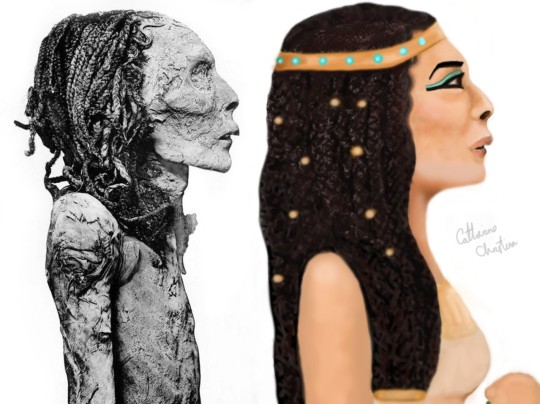
Based upon the mummy believed to be that of Ahmose Nefertari, the deified mother of Amenhotep I.
#ancient egypt#mummies#artists on tumblr#ahmose-nefertari#ahmose nefertari#new kingdom#egyptology#18th dynasty#amenhotep i
14 notes
·
View notes